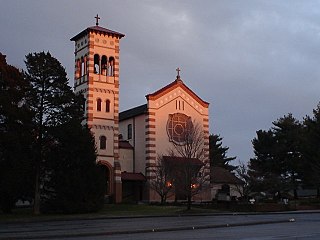
The Capitolium or Capitoline Hill, between the Forum and the Campus Martius, is one of the Seven Hills of Rome.

The Galleria Borghese is an art gallery in Rome, Italy, housed in the former Villa Borghese Pinciana. At the outset, the gallery building was integrated with its gardens, but nowadays the Villa Borghese gardens are considered a separate tourist attraction. The Galleria Borghese houses a substantial part of the Borghese Collection of paintings, sculpture and antiquities, begun by Cardinal Scipione Borghese, the nephew of Pope Paul V. The building was constructed by the architect Flaminio Ponzio, developing sketches by Scipione Borghese himself, who used it as a villa suburbana, a country villa at the edge of Rome.

The Janiculum, occasionally known as the Janiculan Hill, is a hill in western Rome, Italy. Although it is the second-tallest hill in the contemporary city of Rome, the Janiculum does not figure among the proverbial Seven Hills of Rome, being west of the Tiber and outside the boundaries of the ancient city.

Villa Borghese is a landscape garden in Rome, containing a number of buildings, museums and attractions. It is the third-largest public park in Rome, after the ones of the Villa Doria Pamphili and Villa Ada. The gardens were developed for the Villa Borghese Pinciana, built by the architect Flaminio Ponzio, developing sketches by Scipione Borghese, who used it as a villa suburbana, or party villa, at the edge of Rome, and to house his art collection. The gardens as they are now were remade in the late 19th century.

The Capitoline Triad was a group of three deities who were worshipped in ancient Roman religion in an elaborate temple on Rome's Capitoline Hill. It comprised Jupiter, Juno and Minerva. The triad held a central place in the public religion of Rome.
Donglü, also written as Donglu, is a village in Donglü Town, in Qingyuan District, Baoding, Hebei province, China. It has become known for the apparition of the Blessed Virgin Mary, known as Our Lady of China, witnessed there in 1900, and the Marian shrine and pilgrimage site which have since developed.

The Temple of Jupiter Optimus Maximus, also known as the Temple of Jupiter Capitolinus, was the most important temple in Ancient Rome, located on the Capitoline Hill. It was surrounded by the Area Capitolina, a precinct where numerous shrines, altars, statues and victory trophies were displayed.

The Capitoline Museums are a group of art and archaeological museums in Piazza del Campidoglio, on top of the Capitoline Hill in Rome, Italy. The historic seats of the museums are Palazzo dei Conservatori and Palazzo Nuovo, facing on the central trapezoidal piazza in a plan conceived by Michelangelo in 1536 and executed over a period of more than 400 years.

Scarsellino or Ippolito Scarsella was an Italian mid-to-late sixteenth century reformist painter and one of the most important representatives of the School of Ferrara. His landscapes of both sacred and secular themes strongly anticipate the landscape painting traditions of the 17th century.

David with the Head of Goliath, dated c. 1600-1601, is a painting by the Italian artist Caravaggio (1571–1610), housed in the Kunsthistorisches Museum Gemäldegalerie, Vienna. Peter Robb believes it was acquired by the conde de Villamediana in Naples between 1611 and 1617, as Giovanni Bellori records Villamediana as having returned to Spain with a half-figure of David by Caravaggio.

Olimpia Aldobrandini was a member of the Aldobrandini family of Rome, and the sole heiress to the family fortune.

The Portico Dii Consentes, also known as the Area of the Dii Consentes or the Harmonious Gods, is an ancient structure located at the bottom of the ancient Roman road that leads up to the Capitol in Rome, Italy. The Clivus Capitolinus turned sharply at the head of the Roman Forum where this portico of marble and composite material was discovered and re-erected in 1835.
In computing, Open Data Protocol (OData) is an open protocol that allows the creation and consumption of queryable and interoperable Web service APIs in a standard way. Microsoft initiated OData in 2007. Versions 1.0, 2.0, and 3.0 are released under the Microsoft Open Specification Promise. Version 4.0 was standardized at OASIS, with a release in March 2014. In April 2015 OASIS submitted OData v4 and OData JSON Format v4 to ISO/IEC JTC 1 for approval as an international standard. In December 2016, ISO/IEC published OData 4.0 Core as ISO/IEC 20802-1:2016 and the OData JSON Format as ISO/IEC 20802-2:2016.

Venus with a Mirror is a painting by Titian, now in the National Gallery of Art in Washington, DC, and it is considered to be one of the collection's highlights.

St. Mary's of the Barrens Church is a Catholic Church and former seminary in Perryville, Missouri. St. Mary's is the historic seat of the American Vincentians and since its establishment in 1818 has served as an educational institution, a Vincentian house of formation, and a Vincentian community residence. The complex of eight contributing buildings, one contributing site, and two contributing structures was listed on the National Register of Historic Places in 1995 as St. Mary's of the Barrens Historic District. St. Mary's is the home of the National Shrine of Our Lady of the Miraculous Medal.

The Nativity of the Blessed Virgin Mary Church was a Roman Catholic church in Belgique, Missouri.

The Capitoline Brutus is an ancient Roman bronze bust traditionally but probably wrongly thought to be an imagined portrait of the Roman consul Lucius Junius Brutus. The bust has long been dated to the late 4th to early 3rd centuries BC, but is perhaps as late as the 2nd century BC, or early 1st century BC.

Vito Bongiorno is an Italian artist known for making art out of charcoal.

Self-Portrait is a self-portrait in oils by the Italian painter Giovanni Bellini, dating to c.1500 and now in the Galleria Capitolina of the Capitoline Museums in Rome.
















